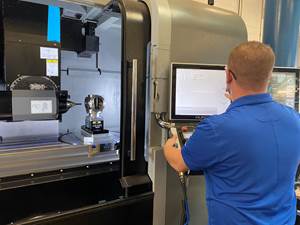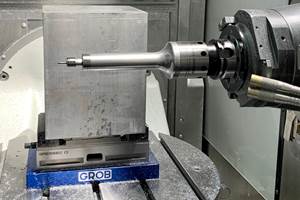Share





One of the most reliable ways machine tool builders maintain workpiece stability is to build a sturdy, heavy frame and a solid bed to reduce the miniscule movements during machining that can cause tool deflection or chatter. However, five-axis machines have a somewhat less-stable worktable design. This is because of the rotation they must provide to position part at different angles.
According to Makino, different five-axis configurations have different benefits and challenges to consider, being that tilting the worktable along the A or B axes can compromise rigidity. For example, at certain positions, a swinging trunnion table can introduce leverage that amplifies micro-movements in the workpiece when the cutting tool makes contact, possibly resulting in deflection and chatter. While this loss of rigidity can be frustrating, the benefits of the complex contouring and single-setup machining are often more than enough to justify the investment. However, Makino recently developed the D200Z, which it says is designed to eliminate the need for a compromise. The company displayed the machine at Amerimold 2018, where it demonstrated how the CNC vertical machining center (VMC) achieves five-axis movement through a set of two integral rotating tables, one of which is tilted at a 44.5-degree angle.
According to the company, the permanent 44.5-degree tilt is a critical aspect of this rotary-table design. The tilted plate rotates about the B axis, while the rotary table attached to it rotates along the C axis, together enabling full five-axis machining and 3+2 machining. While a trunnion design involves making wide swings that drastically alter the center of gravity of the table, the D200Z can rotate fully around both axes within a comparatively small area. This improves stability by maintaining a center of gravity entirely within the physical diameter of the table’s bearings. The primary limitations are the size and mass of the workpiece. If it is larger than 165 pounds (75 kg), the benefits of the tilted rotary table begin to decrease compared to larger trunnions or articulated spindles.
Designed for Moldmaking
Machine rigidity is particularly important in moldmaking applications. High-speed machining to precise tolerances requires anticipating chatter or deflection to avoid scrapping an expensive mold core or cavity. “The table design ensures that the center of gravity is always within the capture range of the bearings,” says Bill Howard, Makino product line manager. “Therefore, regardless of the desired angle or rotary position, the design provides and maintains stiffness and rigidity, as well as ensures excellent kinematics and motion control.” By balancing the need for maintaining rigidity, the D200Z is designed to reduce chatter and deflection in mold machining, as well as other applications that require high precision or have complex part geometries.
Additionally, the tilted rotary table is said to ensure sufficient clearance for the spindle to access critical part features. With a free-standing rotary surface that only attaches to the rest of the machine from the bottom-center of the table, the spindle is designed to easily access five sides of a part, and the cutting tool can reach deep into pockets for molds. The table’s geometric simplicity also simplifies chip evacuation, as moving to a vertical position enables chips to fall into a conveyor, available as a standard feature.
A Compact Solution
The compact work area also reduces the machine’s footprint, leaving room for attached tool changers or automation cells. Further, the small work area and tilted table reduce the distance operators have to reach in order to load and unload parts, reducing the physical toll and increasing the ergonomics for the user.
Additionally, the compact workspace increases manufacturing speed. Because the machine tool is capable of achieving full five-axis movement and positioning in a small work area, it requires relatively small movements to reach desired orientations. The small movements translate into fast positioning for the workpiece.
Proper Programming
Mr. Howard asserts that anyone used to working with five-axis CNC machines should have no problem programming this one. “I would think that anyone familiar with any CAD/CAM system that generates and evaluates tool paths for five-axis machines would have no difficulty programming the D200Z,” he says.
Related Content
Inside a CNC-Machined Gothic Monastery in Wyoming
An inside look into the Carmelite Monks of Wyoming, who are combining centuries-old Gothic architectural principles with modern CNC machining to build a monastery in the mountains of Wyoming.
Read MoreDoes a Five-Axis Machine Increase Business?
Five-axis machining is enabling custom fabricator Meyer Tool to take on more complex work and helping it produce less complex jobs more efficiently.
Read MoreFive-Axis Machines Speed NASCAR Engine Production
Moving from an aging set of five-axis mills to more advanced machines enabled Hendrick Motorsports to dramatically improve its engine production.
Read MoreHigh RPM Spindles: 5 Advantages for 5-axis CNC Machines
Explore five crucial ways equipping 5-axis CNC machines with Air Turbine Spindles® can achieve the speeds necessary to overcome manufacturing challenges.
Read MoreRead Next
AMRs Are Moving Into Manufacturing: Considerations for Implementation
AMRs can provide a flexible, easy-to-use automation platform so long as manufacturers choose a suitable task and prepare their facilities.
Read MoreLast Chance! 2025 Top Shops Benchmarking Survey Still Open Through April 30
Don’t miss out! 91ÊÓƵÍøÕ¾ÎÛ's Top Shops Benchmarking Survey is still open — but not for long. This is your last chance to a receive free, customized benchmarking report that includes actionable feedback across several shopfloor and business metrics.
Read MoreMachine Shop MBA
Making Chips and 91ÊÓƵÍøÕ¾ÎÛ are teaming up for a new podcast series called Machine Shop MBA—designed to help manufacturers measure their success against the industry’s best. Through the lens of the Top Shops benchmarking program, the series explores the KPIs that set high-performing shops apart, from machine utilization and first-pass yield to employee engagement and revenue per employee.
Read More























